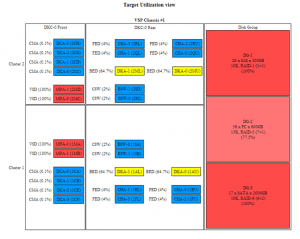The Perfonics™ Calculator – Storage Consolidation Modeling Simulation
If you work with large enterprises, especially with projects that involve tech-refreshes, data center migrations or storage optimizations, it is probably very difficult if not impossible to find Storage consolidation and modeling tools that can provide a view into the current storage infrastructure and help you create a consolidation model that can be sold to the business users and upper management. The question is how does one perform storage optimization and Storage consolidation modeling for the best bang for the buck and still be able to confidently satisfy the SLA for the business users that are used to a certain level of service from their current storage infrastructure.
There are two components to this analysis. One is to understand what IO profiles are being sustained at the current storage infrastructure and at what service level (e.g. response times). The second component is to take the current IO profiles aggregate them over a peak day and use that as a input to a consolidation modeling tool. If you are wondering how to get this kind of analysis done for a large enterprise class storage environment, then you may want to familiarize yourself with the Interscape’s Performance As A Service™ that leverages it’s Perfonics™ toolset to do this in a very efficient manner with fully hands-off approach for the client. This is a full service concept providing a expert included service that has been utilized by many large wall street financial companies running on various vendor platforms such as EMC, HDS, IBM or HP.
For those who understand their storage environment and would like to play around with some consolidation models, Interscape just announced their online tool (Beta) called Perfonics™ calculator that can help with this analysis. The Perfonics™ calculator can help you providing consolidation modeling view from one platform to other, thus providing you a unique capability that does not exist even at the large storage manufacturers. Keep in mind though that there are assumptions that are made and the tool is still in beta form. We welcome your input, so please give this a try, by clicking on the link below:
https://www.perfonics.com/tools/perfonics_calculator.php
The Perfonics™ Calculator Tool
Perfonics™ calculator is an online analysis tool that can be used for consolidation planning and modeling for various storage vendor platforms based on a fixed capacity and performance requirements. The source arrays and target arrays do not have to be from the same vendor or of same model.
At a high level the user needs to provide aggregated source array performance (IOPS) and capacity numbers (TB), select a target array platform and the tool will show how the target utilization would look like for all critical array components. A balanced target view is shown for target utilizations assuming that enough planning has been done to load balance across the front-end and back-end components.
Critical data points needed for the modeling analysis:
For Source Arrays:
• Critical Performance metrics
- Throughput IO/sec
- Bandwidth MB/sec
- Read/Write ratios
- Front-end and Back-end IOPS and MBPS requirements
• Usable storage capacity requirements in TB
For Target Arrays:
- Target array vendor platform model
- Microcode/Firmware planned
- Critical component configurations for Front-end and Back-end directors
- Cache configuration and Cache %Hit assumptions
- Threshold to plan for
- Additional load factor required, if any
- Disk Pool configurations (type, size, RPM, RAID levels etc)
Once all the source data is entered, and all the target configuration added, a report can be generated that will show all source array inputs entered, target array configurations, and a heat chart that will show the model in terms of expected utilizations for the critical components for the selected target array model.
Storage Consolidation Model Shows the following key information:
- Capacity utilizations expected – raw and usable (TB)
- Target heat chart showing expected resource utilizations at each of the configured hardware component level
- Maximum recommended IOPS for front-end, back-end and diskgroups
Here is an example of a target HDS VSP array with modeled utilizations:

